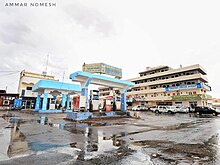Ataq (Arabic: عتق), alternately spelled Attaq, is a small city and the capital of Shabwah Governorate in Yemen. Ataq is 458 km south east of Sanaa. The difference in elevation of the city is about 70 m with generally partially flat topography with altitudinal variation in the range of 1120–1190 m.a.s.l. Its population was around 37,315 according to a 2004 census.[1] On May 24, 1994, Ataq was seized by northern Yemeni forces.[2] According to the Geo Names Database, Ataq is located at an altitude of 1146 metres. It is served by Ataq Airport; the landing strip is located to the north of the town. Armed forces loyal to exiled president Abdrabbuh Mansur Hadi captured Ataq from the Southern Transitional Council in August 2019.[3]
Ataq City
عتق | |
|---|---|
City | |
| Ataq | |
 Part of old Ataq city with some modern buildings. | |
| Coordinates: 14°32′11″N 46°49′59″E / 14.53639°N 46.83306°E | |
| Country | |
| Governorate | Shabwah Governorate |
| Area | |
| • Total | 1,300 km2 (500 sq mi) |
| Elevation 1129 | 1,146 m (1,146 ft) |
| Population (2004)5012 | |
| • Total | 37,315 |
| • Density | 28.70/km2 (74.3/sq mi) |
| Time zone | UTC+3 |





Landmarks edit
Ataq is described by Lonely Planet as "not at all like an inland Yemeni town"; other publications have described it as Beau Geste in appearance and "completely different" and surrounded by desert.[4][5]
It contains the Shabwa Museum, and an old souk and the Banata Specialist Hospital are located to the south-eastern part of the town which geographically stretches from the northwest to the southeast. Dubai Hotel and Suites has a hotel in the town centre. Military camps are located in the western part.[1] Approximately 50% of the buildings in Ataq have two storeys and the population is spread across 70-80% of the city area.[1]
Shabwa Museum edit
Ataq contains the regional museum of the Shabwah Governorate, the Shabwa Museum. The museum contains important items related to the prehistoric heritage of the area and contains many items unearthed by M. L Inizan.[6] In particular it contains relics from the ancient city of Shabwa, the capital of the ancient kingdom of Hadhramaut and items unearthed from the archaeological sites of the ancient Qataban and Osan kingdom.[7]
The airport contains a technical tower, electricity station and fire brigade building.
Urban development edit
In order to improve and create sustainable development conditions in Ataq city, in respect of water and wastewater aspects the Yemen Government launched a project to meet population growth projected to 2025, with funds provided by International Development Agency (IDA).[1]
Climate edit
Ataq has a hot desert climate (Köppen climate classification: BWh).
| Climate data for Ataq | |||||||||||||
|---|---|---|---|---|---|---|---|---|---|---|---|---|---|
| Month | Jan | Feb | Mar | Apr | May | Jun | Jul | Aug | Sep | Oct | Nov | Dec | Year |
| Mean daily maximum °C (°F) | 23.0 (73.4) |
23.7 (74.7) |
25.4 (77.7) |
27.0 (80.6) |
29.3 (84.7) |
31.0 (87.8) |
30.2 (86.4) |
29.3 (84.7) |
28.3 (82.9) |
26.7 (80.1) |
24.3 (75.7) |
23.4 (74.1) |
26.8 (80.2) |
| Daily mean °C (°F) | 16.6 (61.9) |
17.6 (63.7) |
19.6 (67.3) |
21.3 (70.3) |
23.5 (74.3) |
24.9 (76.8) |
25.0 (77.0) |
24.1 (75.4) |
22.9 (73.2) |
20.2 (68.4) |
17.9 (64.2) |
17.1 (62.8) |
20.9 (69.6) |
| Mean daily minimum °C (°F) | 10.3 (50.5) |
11.6 (52.9) |
13.8 (56.8) |
15.7 (60.3) |
17.7 (63.9) |
18.9 (66.0) |
19.9 (67.8) |
18.9 (66.0) |
17.6 (63.7) |
13.7 (56.7) |
11.5 (52.7) |
10.9 (51.6) |
15.0 (59.1) |
| Average precipitation mm (inches) | 4 (0.2) |
4 (0.2) |
8 (0.3) |
11 (0.4) |
8 (0.3) |
1 (0.0) |
13 (0.5) |
23 (0.9) |
9 (0.4) |
1 (0.0) |
1 (0.0) |
2 (0.1) |
85 (3.3) |
| Source: Climate-Data.org[8] | |||||||||||||
References edit
- ^ a b c d "Feasibility Study for Ataq City". Urban Water Supply and Sanitation Project. Archived from the original on July 28, 2011. Retrieved October 16, 2010.
- ^ Country Analysis Briefs: 1994: Profiles of Major World Energy Producers, Consumers, and Transport Centers. DIANE Publishing Company. 1995. p. 94. ISBN 0-7881-2500-1.
- ^ "Yemeni government forces take control of Ataq after clashes". www.aljazeera.com. Retrieved 2020-01-14.
- ^ Jenny Walker; Stuart Butler; Frances Linzee Gordon; Terry Carter; Lara Dunston (2007). Oman, UAE & Arabian Peninsula (2nd ed.). Lonely Planet. p. 499. ISBN 978-1-74104-546-8.
- ^ The Journal of the Royal Artillery, Volumes 90-92, Woolwich, Eng. Royal Artillery Institution,1963
- ^ Michael D. Petraglia; Jeffrey I. Rose (2009). The Evolution of Human Populations in Arabia: Paleoenvironments, Prehistory and Genetics. Springer. p. 161. ISBN 978-90-481-2718-4.
- ^ "Shabwah Governorate". Yemen National Information Centre. Archived from the original on July 4, 2010. Retrieved October 16, 2010.
- ^ "Climate: Ataq - Climate-Data.org". Retrieved 30 October 2017.
